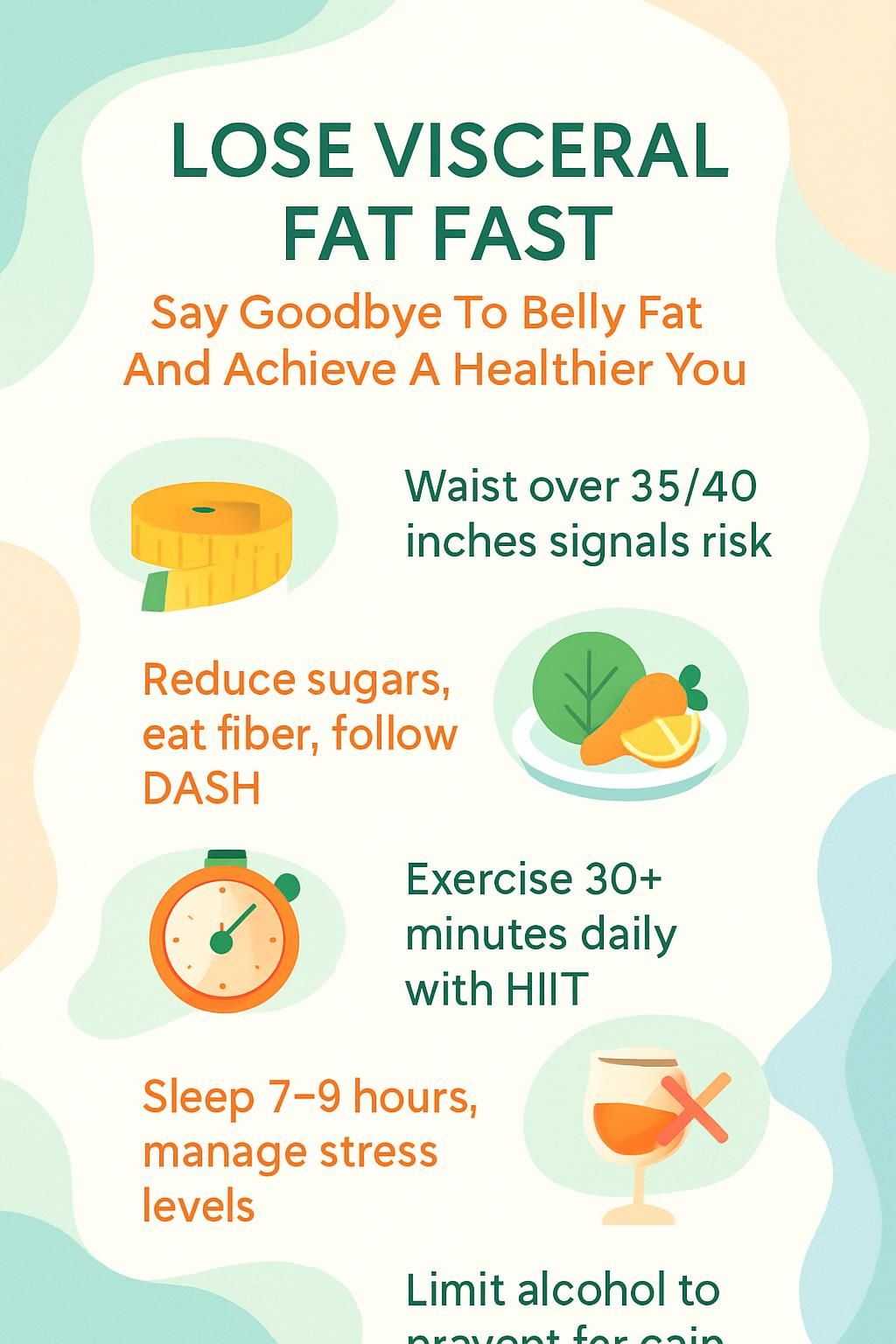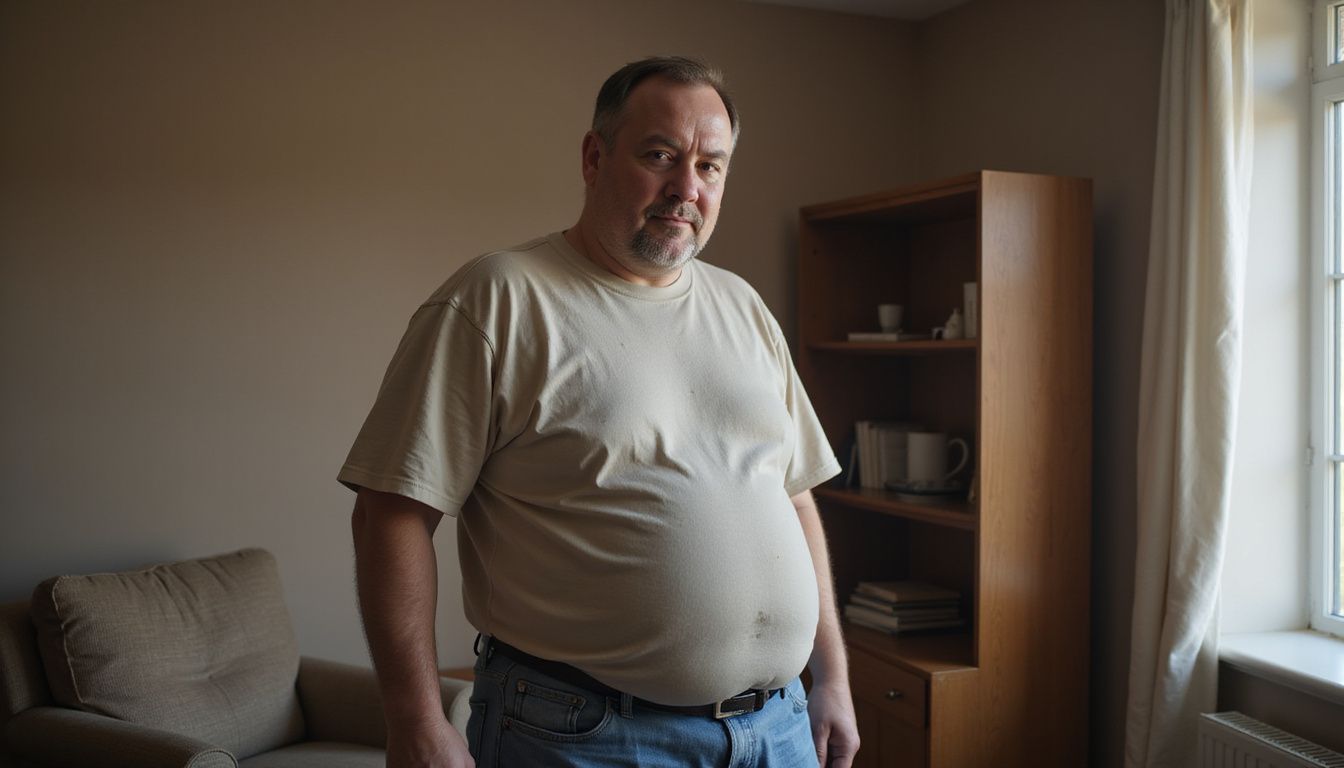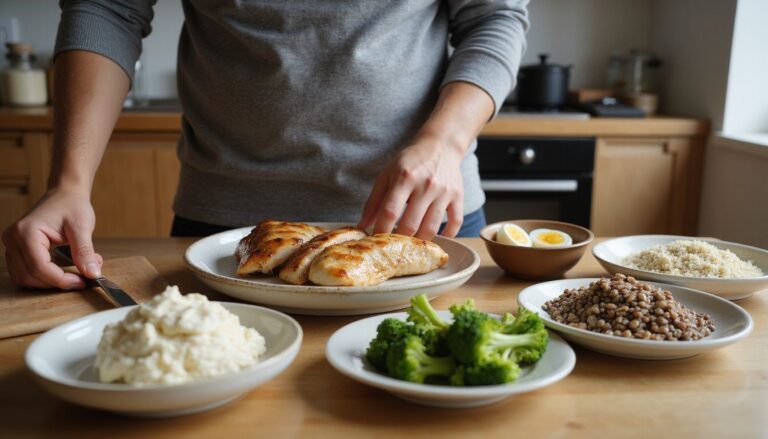Lose Visceral Fat Fast: Say Goodbye To Belly Fat And Achieve A Healthier You
Our Nutrition Assistant AI Suite will transform your body. You will lose fat, get toned, and build muscle. Gain confidence and optimal health.
If stubborn belly fat hangs on no matter what you try, you are not alone. Visceral fat, the deep fat around your organs, affects health more than the soft fat under your skin. This guide shows proven ways to lose belly fat and reduce visceral fat with smart food choices, exercise, and daily habits.
Each step is simple and doable. You will learn exactly what to change and how to track progress.
Key Takeaways
- Visceral fat sits deep in your abdomen and raises health risks, including heart disease and type 2 diabetes. A waist over 35 inches in women or 40 inches in men signals higher risk.
- Cutting added sugar, eating more fiber and protein, and using a Mediterranean or DASH style plan can improve metabolic health and trim belly fat within 2–3 months.
- Move at least 30 minutes most days. HIIT and strength training reduce visceral fat faster than easy workouts alone.
- Poor sleep and chronic stress raise cortisol, a stress hormone that promotes abdominal fat. Aim for seven to nine hours of quality sleep and use stress tools daily.
- Limiting alcohol cuts empty calories and helps your body burn stored fat more efficiently.

What Is Visceral Fat?

Visceral fat is the hidden fat that wraps around your liver, stomach, and intestines. It is different from the soft fat you can pinch. High levels raise the risk of disease.
What is visceral fat?
Visceral fat is the deep fat stored inside your abdomen and chest around vital organs like the liver and kidneys. The word viscera means internal organs. A small amount cushions organs and supports normal body functions.
Experts call it active fat because it releases hormones and chemical signals that affect metabolism and energy use. For most people, about 10 percent of total body fat is visceral fat. It collects in an area called the omentum, which thickens with weight gain.
Fat cells, called adipocytes, in this area respond to hormones such as insulin and cortisol. I learned my visceral fat was high after a routine visit, when my waist measured a little over 40 inches.
Excessive visceral fat places you at higher risk for cardiovascular disease.
Everyone holds some hidden belly fat. Trouble starts when there is too much. High levels link to type 2 diabetes, high blood pressure, stroke, some cancers, and metabolic syndrome.
How is visceral fat different from subcutaneous fat?
You carry two main types of belly fat. Subcutaneous fat sits just under the skin. It makes up about 90 percent of total body fat and acts as insulation and energy storage. You can grab it on the hips, thighs, and belly.
Visceral fat lies under the abdominal wall and wraps organs like the liver and intestines. It makes up a smaller share of body fat but carries greater health risks.
Visceral fat behaves like an endocrine organ, releasing molecules called cytokines that spark low-grade inflammation. It also sends signals that can raise blood pressure. Research since the 1990s links higher visceral fat with insulin resistance, heart disease, and higher cholesterol.
The good news, it responds well to diet and exercise. Many people notice their waist shrinks early in weight loss.
Why Is Visceral Fat Dangerous?
Hidden fat close to your organs does more than change body shape. It disrupts hormones, raises inflammation, and strains your heart and blood vessels.
What health risks does visceral fat cause?
Excess visceral fat raises the risk of major health problems. Among midlife and older women, a larger waist more than doubles heart disease risk, even after adjusting for blood pressure and BMI.
Every extra two inches of waist size raises cardiovascular risk by about 10 percent. People often see higher blood pressure, higher blood sugar, higher triglycerides, and lower HDL, the good cholesterol.
Carrying too much visceral fat is linked to metabolic syndrome, type 2 diabetes, high cholesterol, and atherosclerosis. With age, body fat often shifts to the abdomen, even if body weight stays similar.
Waist size can rise without large changes on the scale. Spotting this early helps you take action. A quick note for accuracy, thresholds used here align with guidance from groups like the CDC and the American Heart Association.
How does visceral fat relate to diabetes and heart disease?
Visceral fat releases hormones and cytokines, small proteins that increase inflammation. Ongoing inflammation drives insulin resistance, which sets the stage for diabetes.
Deep abdominal fat also prompts chemicals that raise blood pressure and worsen cholesterol. These changes damage arteries and strain the circulatory system. Together, they create metabolic syndrome, which sharply raises the risk of heart attack and stroke.
During my own cutback plan, my doctor tracked waist size, blood pressure, and fasting glucose. Modest drops in waist size improved those numbers within weeks.
Causes of Visceral Fat Accumulation
Several factors push the body to store fat deep in the abdomen. Knowing the causes helps you target the real problem, not just the symptom.
Poor diet and high-calorie intake
Diets high in added sugar and refined carbs drive belly fat gain. Sodas, sweets, and many packaged foods make it easy to overshoot your calorie needs. A small daily surplus adds up over time.
Alcohol adds many empty calories and burdens the liver’s fat processing, which can increase visceral fat. Genes can amplify risk, especially when eating patterns are unbalanced.
Shifting to whole grains, lean proteins, vegetables, and a Mediterranean or DASH style plan can reduce visceral fat and improve metabolic health.
Lack of physical activity
Too many calories plus long periods of sitting is a tough combo. Desk work, long commutes, and screen time all boost fat stored around the abdomen.
Research links sedentary time with more total fat and more organ-surrounding fat. Aim for at least 30 minutes of movement most days. Brisk walking, cycling, and aerobic exercise help you lose weight and keep it off.
Strength training adds muscle, which raises calories burned at rest. HIIT often reduces abdominal obesity faster than light exercise. Small choices count, such as taking the stairs or parking farther away.
Stress and hormonal imbalances
Chronic stress raises cortisol, your main stress hormone. Cortisol signals the body to store fat around the organs. Short sleep makes this worse, especially in adults under 40.
Hormone disorders such as Cushing syndrome or hypothyroidism can also push fat to the abdomen. These conditions change how your body uses energy and controls blood pressure.
In my own life, adding evening breathing exercises and a steady sleep schedule trimmed my waist over a few months.
Genetic predisposition
Genetics shape where your body stores fat, including around the organs. A family history of obesity or metabolic syndrome increases your chance of carrying extra belly fat.
Some people gain abdominal fat more easily, even with a solid diet and exercise plan. Birth weight, pregnancy history, and menopause also change fat distribution over time.
Genes affect waist–hip ratio and how quickly your abdomen stores fat. Tracking your own pattern helps you tailor strategies that fit your body.
How to Identify Visceral Fat
You can check risk at home with a tape measure, then discuss more precise tools with a clinician if needed.
How do you measure waist circumference?
Stand up and wrap a flexible tape measure level with the top of your right hip bone, across your belly button. Do not pull the tape tight. Breathe out gently and note the number.
For women, 35 inches or more signals higher risk. For men, 40 inches or more signals higher risk. Recheck every few weeks to track change, since body shape can shift even when weight looks steady.
Some clinicians also use waist-to-hip or waist-to-height ratios. If your waist is more than half your height, risk rises for prediabetes and heart disease.
What are the limits of BMI in detecting visceral fat?
BMI estimates weight relative to height but does not show where fat sits. It cannot distinguish visceral fat from subcutaneous fat.
Some people with a normal BMI still have high visceral fat, often called normal-weight obesity. Others, such as athletes with more muscle, may have a high BMI but low visceral fat.
Track waist size alongside BMI for a clearer picture, especially as you age and body composition changes.
What medical imaging techniques detect visceral fat?
CT and MRI scans measure visceral fat with high accuracy. They show the exact location of fat and separate subcutaneous from deep abdominal fat.
These tests are used in research or complex cases because they cost more and are not always available. For most people, a tape measure is enough to monitor risk and progress.
In my experience with clients, waist measurements give faster feedback than waiting for imaging. Use imaging only when your healthcare provider suggests it.
Effective Ways to Lose Visceral Fat Fast
Target the drivers of fat gain, and your waist starts to move. Food choices, activity, sleep, and stress control work together like gears in a machine.
Dietary Changes
Food is the most powerful lever for fat loss. These strategies help trim visceral fat within 2–3 months, and they support long-term health.
- Follow Mediterranean or DASH principles. Focus on vegetables, fruits, olive oil, fish, beans, nuts, and whole grains to reduce fat stored in the abdomen.
- Cut added sugars and sweetened drinks. Many packaged foods in the United States hide sugar that drives belly fat.
- Consider intermittent fasting, if appropriate. Periods without food can shift your body to burn stored fatty acids, including visceral fat.
- Boost fiber and lean protein at each meal. Fiber slows digestion, protein supports metabolism and appetite control.
- Limit alcohol. It adds empty calories and raises liver fat, which makes fat loss harder.
- Choose lean proteins like fish, poultry, beans, and low-fat dairy. Lower saturated fat supports heart health and reduces fat storage.
- Ask a healthcare professional for personalized guidance, especially if you have diabetes, hypertension, or other conditions.
- Track meals. Simple logging prevents hidden calorie creep and reveals high sugar or saturated fat sources.
- Swap processed snacks for nuts, fruit, or cut vegetables. These options are nutrient dense and linked to less visceral fat over time.
Meal planning with Mediterranean recipes helped me drop two inches off my waist in about 10 weeks. Energy improved, and eating felt easier to manage.
Adopting a Mediterranean diet
This pattern emphasizes plants, whole grains, beans, seafood, and olive oil, while limiting fatty meats and processed foods. Replacing butter and high saturated fat meats with olive oil and fish supports heart and metabolic health.
Systematic reviews report smaller waists and better blood sugar control with this approach. High-fiber foods keep you full longer, which helps you stick with it.
Quick example, build a colorful salad with beans, greens, tomatoes, whole grains, and a drizzle of olive oil. Add grilled salmon or chicken for protein.
Reducing sugar and processed foods
Cutting back on added sugar gives your plan an extra push. Sugary drinks, candies, and desserts raise visceral fat over time.
Processed snacks and ready meals often hide sugar and low-quality fats that promote fat storage. Limiting refined carbs reduces insulin spikes that drive fat gain.
Read labels to spot added sugars. Cooking more at home gives you control over ingredients and portions. I saw fewer cravings after trading soda for water and unsweetened tea.
Increasing fiber and protein intake
High-fiber foods such as whole grains, beans, fruits, and vegetables help control hunger and calories. Research links higher fiber intake to less abdominal fat.
Lean protein preserves muscle as you lose weight and steadies appetite hormones. Choose fish, poultry, eggs, tofu, and yogurt. I like adding Greek yogurt or a handful of nuts at breakfast to stay full until lunch.
Exercise Strategies
Food changes start the process. Exercise speeds it up and helps you keep results.
- Accumulate at least 150 minutes of moderate activity weekly. Mix cardio with strength training for the biggest impact.
- Use High-Intensity Interval Training, or HIIT, to accelerate fat loss. Short bursts of hard work followed by brief rest burn more fat in less time.
- Include resistance moves, such as squats, rows, planks, and crunches, to build and maintain muscle.
- Stack movement into your day. Walk more, take stairs, and do active chores to raise daily calorie burn.
- Keep going after you lose weight. Consistent workouts help prevent fat regain.
- Try aerobic favorites like brisk walking, cycling, or swimming. Cardio targets deep abdominal fat and supports heart health.
- Limit alcohol to protect workout gains and reduce extra calories.
I used two months of HIIT, alternating sprints and walking. My waist shrank faster than with steady jogging, and my energy improved.
What is High-Intensity Interval Training (HIIT)?
HIIT alternates short bursts of near-max effort with short rest. For example, push hard for 30 seconds, then go easy for 30 to 60 seconds. Repeat for 20 to 30 minutes.
Studies show HIIT can reduce abdominal and visceral fat quickly and improve metabolic health. It works with many modes, such as sprints, cycling, or bodyweight circuits. Even 30 minutes, five days per week, produces strong results, and calories keep burning after the workout ends.
How do strength training and resistance exercises help?
Muscle burns more calories at rest than fat. Strength work builds or preserves muscle as you lose weight, which raises your resting metabolism.
Combining strength training with cardio reduces visceral fat better than cardio alone. Aim for at least two strength sessions weekly using weights, machines, or resistance bands.
Resistance work also helps prevent fat regain. A stronger core supports better posture and daily activity.
Which aerobic activities burn visceral fat?
Brisk walking, cycling, swimming, and jogging all help burn visceral fat. Aim for at least 30 minutes most days to raise your heart rate and boost fat use.
Swimming engages large muscle groups and supports joints. Walking after meals helps blood sugar control and adds to daily movement. Combine cardio with strength training for the best defense against fat regain.
Lifestyle Adjustments
Daily habits shape hormones, appetite, and recovery. Small changes add up over weeks and months.
- Manage stress with mindfulness, breathing, prayer, or journaling. Lower cortisol reduces fat storage in the abdomen.
- Sleep 7 to 9 hours nightly. Better sleep supports appetite control and metabolism.
- Limit alcohol. Even modest intake can slow fat burning and add calories.
- Track waist size. Keep it under 35 inches for women and under 40 inches for men to lower risk.
- Set regular times for meals, movement, and sleep. A steady routine supports hormone balance.
- Choose enjoyable activities. Short walking or stretching breaks during work keep you moving.
- Swap sugary snacks for fruit, nuts, or yogurt. Reduce processed foods that trigger overeating.
- Stay hydrated. Water helps curb cravings and supports energy for exercise.
When I monitored sleep and cut back on drinks, my waist and cravings changed within two months. Consistency did the heavy lifting.
How can you manage stress to lose belly fat?
Stress raises cortisol, which pushes fat to the abdomen. Mindfulness, breathing drills, and short daily walks lower tension and support better choices at meals.
Social support also helps. A quick check-in with a friend or a group class can ease stress and improve adherence.
Ten minutes of meditation each day improved my sleep and reduced snack cravings. Hobbies like painting or playing with a pet can offer the same relief.
Why is quality sleep important for fat loss?
Short sleep disrupts hunger hormones and raises cortisol. Adults under 40 who sleep five hours or less tend to gain more visceral fat.
Aim for seven to eight hours of quality rest. Keep a regular bedtime, dim lights, and cool your room. Treat sleep disorders with your clinician if needed.
With better sleep, exercise feels easier, and food choices improve.
How does limiting alcohol reduce visceral fat?
Alcohol delivers many calories with little nutrition. Your liver prioritizes clearing alcohol, which delays fat burning for hours.
Frequent drinking links to larger waists and more abdominal fat. Alcohol can also disrupt sleep and lead to high-calorie snacking.
Switching to water or low-calorie drinks can remove hundreds of calories each week. I saw faster changes after choosing non-alcoholic options at social events.
Foods That Help Reduce Visceral Fat
Some foods make it easier to manage appetite, steady blood sugar, and support your heart, all key for trimming deep abdominal fat.
What MUFA-rich foods reduce visceral fat?
Monounsaturated fats, or MUFAs, help lower bad cholesterol and improve insulin sensitivity. Olive oil, avocados, almonds, peanuts, and walnuts are great choices.
Replacing saturated fats with MUFAs is tied to smaller waists and less belly fat. These foods also increase fullness, which can reduce total calorie intake.
How does green tea support fat burning?
Green tea contains catechins, antioxidants that may boost metabolism and increase fat burning. Several studies suggest regular intake helps reduce abdominal fat and supports heart health.
Swap sugary drinks for 2–3 cups of green tea daily. It is low in calories and pairs well with exercise for greater results.
Why choose lean proteins and whole grains?
Lean proteins preserve muscle during weight loss and help control appetite. Try fish, chicken, beans, lentils, tofu, and low-fat dairy.
Whole grains add fiber for gut health and steady energy. Replacing refined grains with brown rice, oats, or 100 percent whole wheat products is linked to less visceral fat over time.
When I switched to whole grain bread and added beans more often, staying full got easier and snacking dropped.
Misconceptions About Losing Belly Fat
Misleading claims waste time and energy. Clear science keeps your efforts focused.
Why doesn’t spot reduction work?
Working one area cannot force fat loss from that spot. Crunches strengthen your core, but they do not target visceral fat around your organs.
Calorie deficit and whole-body training reduce fat everywhere, including the abdomen. Marketing claims for spot reduction lack scientific support.
How does overall fat loss affect belly fat?
Your body decides where fat comes off first. With steady calorie control and exercise, total fat drops, including deep abdominal fat and the fat under your skin.
Waist size often shrinks early because visceral fat responds quickly to lifestyle changes. Tracking your waist weekly can motivate you more than the scale.
Some people find that intermittent fasting helps them use stored fat between meals. Keeping healthy habits for months prevents the fat from returning.
Long-Term Strategies to Maintain a Healthy Weight
Short bursts help you start. Simple systems help you stay the course.
How to stay consistent with diet and exercise?
Create a weekly plan. Schedule at least 30 minutes of movement most days, mixing cardio and strength work. Follow a Mediterranean or DASH style plan for meals.
Intermittent fasting can help some people break plateaus. Measure your waist monthly to see steady change, even when weight stalls.
I struggled until I picked fixed workout times and prepped meals on Sundays. That routine turned effort into habit.
Why are regular health checkups important?
Checkups help catch rising risk early. Clinicians can monitor waist size, blood pressure, blood sugar, and cholesterol to gauge visceral fat effects.
If men measure above 40 inches or women above 35 inches at the waist, risk increases. Your provider can help with personalized steps and safe targets.
These visits connect your habits with your health numbers and keep you accountable.
Conclusion
Reducing visceral fat improves heart health, blood sugar control, and energy. Small changes in diet, movement, sleep, and stress add up to a smaller waist and lower health risks.
Focus on real food, regular exercise, quality sleep, and less alcohol. Stay consistent for 2 to 3 months, then keep going. A safer body and a steadier life follow.
Health information in this article is for education only and does not replace medical advice. Talk with a qualified healthcare professional about your personal plan.
FAQs
1. What is visceral fat and why isn’t it good for health?
Visceral fat is the fat stored deep inside the abdomen, surrounding vital organs. This type of fat isn’t good because it increases the risk of heart disease, type 2 diabetes, and other health problems. Studies show that high levels of visceral fat can disrupt cell function and hormone balance, leading to chronic conditions (Harvard Health Publishing, 2020).
2. How can exercise help reduce belly fat?
Exercise can help reduce belly fat by burning calories and improving metabolism. Activities like crunch exercises target abdominal muscles, while aerobic workouts help burn overall body fat. Research indicates that regular physical activity, such as brisk walking or cycling, can lower visceral fat even without major weight loss (American Journal of Physiology, 2011).
3. Does stress or alcohol affect visceral fat levels?
Stress, as explained in biology, triggers the release of cortisol, a hormone that can increase fat storage in the abdomen. Alcohol, a common drug, adds extra calories and can promote fat gain around the belly. Managing stress and limiting alcohol intake are both linked to lower visceral fat levels (Mayo Clinic, 2022).
4. What foods support losing visceral fat fast?
Eating nutrient-rich foods like nuts, fruits, and vegetables can help reduce belly fat. Nuts provide healthy fats and protein that help control hunger. Fruits offer fiber and vitamins that support cell health. Avoiding processed foods and sugary drinks also helps prevent extra pounds from accumulating as belly fat.
Personal Application: After switching from processed snacks to a handful of nuts and fresh fruit each day, I noticed my energy improved and my waistline shrank over several months.
Summary: Visceral fat isn’t good for health because it surrounds organs and raises disease risk. Exercise can help reduce belly fat by burning calories. Stress and alcohol can increase abdominal fat. Choosing healthy foods like nuts and fruits supports weight loss and better health.







